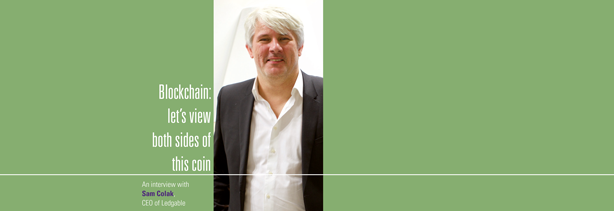Ledgable is a company that provides ‘Blockchain-As-A-Service’ (BAAS): a cloud service which allows businesses to have their own blockchain up and running in less than half an hour. Compact talked to Ledgable’s CEO, mr. Sam Colak, to find out more about Ledgable.
Introduction
With the introduction of Bitcoin in 2008, a new way to register transactions made its appearance. A very interesting new way as it turned out. With blockchain, the technology behind Bitcoin, it is possible to digitally send payments between two parties without needing a third party to verify the transaction.
The name ‘blockchain’ is derived from its nature: a chain of blocks, and every block is made up of transactions. Using cryptography to keep exchanges secure, blockchain provides a decentralized database of transactions that everyone on the network can see.
Blockchain can however be used for more than just cryptocurrencies or payments. Blockchain can also be considered for smart contracts (a programmable contract stored in the chain), compliance and digital identity. The new technology is exciting a lot of people around the world and almost every major financial institution in the world has started up blockchain research.
Ledgable enables its clients to leverage this technology and supplies blockchain as a cloud service, which can be up and running in less than half an hour, with no up-front costs.
Mr. Colak, can you explain how Ledgable came into being?
The initial concept of Ledgable was known as Vault, which was originally focused on high transaction volume bank settlements; a system to challenge SWIFT. Multiple banks would have multiple holding accounts, which would need to be coordinated into a central infrastructure (the Vault).
Vault was designed for banking, but collaboration with clients led to the focus on the banking infrastructure being removed. The system could also serve as a settlement system for businesses. The client needed a mechanism that instantaneously managed and recorded actions in the form of a secure workflow. Blockchain is perfect for this. There was one hiccup: the client was not going to buy a service when he could not put the data infrastructure in his own data center.
On the basis of this we realized that we needed to build a new interface and completely change the user interface. Clients needed to be able to express how data is stored, where it is stored and how many replications the data is stored over. The product changed from account management and financial services, to basically everything. Ledgable now targets all sectors.
What are your clients using blockchain for?
The first set of typical clients comes to Ledgable for disaster recovery scenarios. The infrastructure of clients lacks the capability to deal with failover. Small and medium-sized enterprises do not have the ability to purchase solutions like Oracle and MySQL. Ledgable lets you define any amount of failovers, without impacting the price.
The second set of clients uses Ledgable for regulatory requirements, internal compliance or public relations. They have problems with combining transparency and security. Other blockchains address the sharing and transparency issues by giving a complete copy of the data to everyone (the consortium model). Ledgable avoids opening up the infrastructure to anyone else other than the party that wants to control it and lets the business decide how transparent the model is, without the security implications.
There is one significant client in the USA, which issues debit cards for children. Parents can load this card for lunch/pocket money. The application framework is connected to the Ledgable infrastructure.
What advantages does Ledgable offer to its clients?
Setting up a secure blockchain is not straightforward; cost is a significant aspect. Cost models are often volume or subscription based. Both models have high initial implementation costs, but with Ledgable the infrastructure service is not invoiced to the client. The investment to join Ledgable is zero. The infrastructure on Ledgable’s side is already there. Users pay for each transaction that is written into the blockchain. However, anyone can sign up and use it for free, up to 10.000 records. Conventionally companies set up physically separated Development, Testing, Acceptance and Production (DTAP) environments. With Ledgable you can create four blockchains and call them D, T, A and P.
Are there any unintended consequences of replacing the current trust model with blockchain solutions?
The ramification in using DLT is that it remains a single-source of truth. There is simply no way to argue with the data entered into the service. Companies that misuse negligence or missing information to cover up facts can’t do this anymore.
The infrastructure that holds the data is publicly visible. How do you keep the data secure?
We take security very seriously. Ledgable records between 20.000 and 40.000 security attempts per day to break into the infrastructure. It would be very unwise to disclose our security methods. We have built security that monitors the interaction of users with the data. The cryptographic algorithms are not the problem, rather the software that performs the cryptographic work. Most attacks occur on the surrounding areas, that deal with the entry of data. Jailbreak (the famous iOS hack) for instance, occurred through image library decompression algorithms.
What regulatory challenges are you and your clients facing?
The client is directly responsible for the regulatory requirements. The regulatory implications coincide with the nature of the business and the location where the client wants the data to be stored. Where a company wants to put data, is in their hands. The service itself can be anywhere on the planet. We are able to set up a datacenter at a client’s request and also take the costs for this. We do however have minimum requirements with regard to the data centers.
Does blockchain require standardization?
This depends on whom you talk to: IBM’s Hyperledger tends to do things its own way. Ethereum is more a dictatorship regarding standards. Unfortunately there are a number of forks from the original codebase and so as a result, clients tend to use a platform that is not necessarily guaranteed to be future-proof. Companies tend to buy in and thereafter perform little or no maintenance, unless absolutely necessary.
I do not foresee blockchains being interoperable in the near future. The industry has incentives to keep things separated. The capability to be interoperable is not to the benefit of the companies providing the services.
When will we see more of blockchain and what business models will be disrupted?
The transition to blockchain is already in process. Quite often the visibility is obscured for political reasons. Some blockchains are shared across organizations and consequently this information is sensitive.
Financial or ownership markets are most affected since there is no real way to argue with the recorded information. Where beforehand there was a possibility of human error or data archiving issues, this does not exist with a third party with strong retention policies. Data cannot be ‘manipulated’ by any party once it is written.




